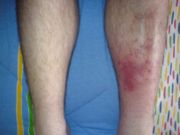Cellulitis causes: Difference between revisions
(→Causes) |
(→Causes) |
||
| Line 5: | Line 5: | ||
==Causes== | ==Causes== | ||
Cellulitis is caused by a type of [[bacterium|bacteria]] entering by way of a break in the skin. This break need not be visible. [[Group A streptococcal infection|Group A]] [[streptococcus]] and [[staphylococcus]] <ref name="pmid6768328">{{cite journal| author=Fleisher G, Ludwig S| title=Cellulitis: a prospective study. | journal=Ann Emerg Med | year= 1980 | volume= 9 | issue= 5 | pages= 246-9 | pmid=6768328 | doi= | pmc= | url=http://www.ncbi.nlm.nih.gov/entrez/eutils/elink.fcgi?dbfrom=pubmed&tool=sumsearch.org/cite&retmode=ref&cmd=prlinks&id=6768328 }} </ref>are the most common of these bacteria, which are part of the normal flora of the skin but cause no actual infection until the skin is broken. Predisposing conditions for cellulitis include insect bite, animal bite, pruritic skin rash, recent [[surgery]], [[athlete's foot]], [[xeroderma|dry skin]], [[eczema]], burns and [[boil]]s, though there is debate as to whether minor foot lesions contribute. Few other causes may be Hemophilus | Cellulitis is caused by a type of [[bacterium|bacteria]] entering by way of a break in the skin. This break need not be visible. [[Group A streptococcal infection|Group A]] [[streptococcus]] and [[staphylococcus]] <ref name="pmid6768328">{{cite journal| author=Fleisher G, Ludwig S| title=Cellulitis: a prospective study. | journal=Ann Emerg Med | year= 1980 | volume= 9 | issue= 5 | pages= 246-9 | pmid=6768328 | doi= | pmc= | url=http://www.ncbi.nlm.nih.gov/entrez/eutils/elink.fcgi?dbfrom=pubmed&tool=sumsearch.org/cite&retmode=ref&cmd=prlinks&id=6768328 }} </ref>are the most common of these bacteria, which are part of the normal flora of the skin but cause no actual infection until the skin is broken. Predisposing conditions for cellulitis include insect bite, animal bite, pruritic skin rash, recent [[surgery]], [[athlete's foot]], [[xeroderma|dry skin]], [[eczema]], burns and [[boil]]s, though there is debate as to whether minor foot lesions contribute. Few other causes may be [[Hemophilus influenza]] especially in facial infections.<ref name="pmid7018329">{{cite journal| author=Fleisher G, Ludwig S, Henretig F, Ruddy R, Henry W| title=Cellulitis: initial management. | journal=Ann Emerg Med | year= 1981 | volume= 10 | issue= 7 | pages= 356-9 | pmid=7018329 | doi= | pmc= | url=http://www.ncbi.nlm.nih.gov/entrez/eutils/elink.fcgi?dbfrom=pubmed&tool=sumsearch.org/cite&retmode=ref&cmd=prlinks&id=7018329 }} </ref> | ||
The appearance of the skin will help a doctor make a diagnosis. The doctor may also suggest blood tests, a wound culture or other tests to help rule out a blood clot deep in the veins of the legs. Cellulitis in the lower leg is characterized by signs and symptoms that may be similar to those of a clot occurring deep in the veins, such as warmth, pain and swelling. | The appearance of the skin will help a doctor make a diagnosis. The doctor may also suggest blood tests, a wound culture or other tests to help rule out a blood clot deep in the veins of the legs. Cellulitis in the lower leg is characterized by signs and symptoms that may be similar to those of a clot occurring deep in the veins, such as warmth, pain and swelling. | ||
Revision as of 05:46, 29 April 2012
Editor-In-Chief: C. Michael Gibson, M.S., M.D. [1]
|
Cellulitis Microchapters |
|
Diagnosis |
|---|
|
Treatment |
|
Case Studies |
|
Cellulitis causes On the Web |
|
American Roentgen Ray Society Images of Cellulitis causes |
Overview
Causes
Cellulitis is caused by a type of bacteria entering by way of a break in the skin. This break need not be visible. Group A streptococcus and staphylococcus [1]are the most common of these bacteria, which are part of the normal flora of the skin but cause no actual infection until the skin is broken. Predisposing conditions for cellulitis include insect bite, animal bite, pruritic skin rash, recent surgery, athlete's foot, dry skin, eczema, burns and boils, though there is debate as to whether minor foot lesions contribute. Few other causes may be Hemophilus influenza especially in facial infections.[2]
The appearance of the skin will help a doctor make a diagnosis. The doctor may also suggest blood tests, a wound culture or other tests to help rule out a blood clot deep in the veins of the legs. Cellulitis in the lower leg is characterized by signs and symptoms that may be similar to those of a clot occurring deep in the veins, such as warmth, pain and swelling.
This reddened skin or rash may signal a deeper, more serious infection of the inner layers of skin. Once below the skin, the bacteria can spread rapidly, entering the lymph nodes and the bloodstream and spreading throughout the body.
In rare cases, the infection can spread to the deep layer of tissue called the fascial lining. Necrotizing fasciitis, also called by the media "flesh-eating bacteria", is an example of a deep-layer infection. It represents an extreme medical emergency.

References
- ↑ Fleisher G, Ludwig S (1980). "Cellulitis: a prospective study". Ann Emerg Med. 9 (5): 246–9. PMID 6768328.
- ↑ Fleisher G, Ludwig S, Henretig F, Ruddy R, Henry W (1981). "Cellulitis: initial management". Ann Emerg Med. 10 (7): 356–9. PMID 7018329.